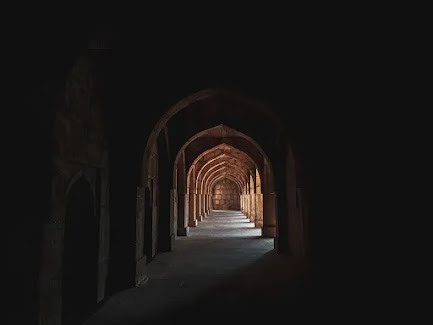 |
| According to his own words, Martin Luther was stalked by a dark, mysterious force during his stay at Wartburg Castle, which tried to hinder him from his Biblie studies |
In 1517, Luther's views culminated in his opposition to the sale of indulgences, that promised to reduce punishment for sins for the donor or their loved ones in purgatory. Luther drafted his Ninety-Five Theses, a set of propositions criticizing the indulgences and other issues, and reputedly nailed them to the door of All Saints' Church in Wittenberg.
Martin Luther at Wartburg Castle
Luther's opinions circulated widely, thanks to the printing press, sparking intense controversy. His refusal to recant his opinions led to his excommunication in 1521 and condemnation as an outlaw by the Holy Roman Emperor. Luther escaped to Wartburg Castle, owned by one of his supporter where he feel safe from arrest. It was during his stay at Wartburg, under the pseudonym "Junker Jörg," that Luther translated the New Testament into German

|
| The room where Martin Luther stayed |
However, Luther's time at Wartburg Castle also became the setting for the strange series of paranormal events. Luther felt during his stay allegedly stalked by mysterious dark presence and experiences several strange events that we can define as unexplained. What happened there. Lets found out together.
Paranormal Experiences of Martin Luther
According Luther, one night after he retired to rest, bag of hazel nuts which had been brought to him by two noble youths who waited upon him with his food, was violently agitated by mysterious power. The nuts rolled and struck against one another with such force that they made the beams of the room to shake , and the bed on which he was lying to rattle. The same night, although the steps leading to his solitary apartment were barred fast with iron chains and an iron door, he was roused from his sleep by a tremendous rumbling up and down the steps, which he describes as though huge beer casks were rolling up and down. Nothing doubting that it was the devil at work trying to disturb him, he got up and walked to the stair's head, and called aloud,
" Is it thou ? be it so then I commend me to the Lord Christ, of whom it is written in the eighth Psalm, Thou hast put all things under His feet. "
On another and still more memorable occasion, as he pored keenly over the pages of his Greek Testament, something started to make a noise behind a stove, just as though someone was dragging some wooden measure along the floor.
" As I found he was going to begin again, " he adds, " I gathered together my books and got into bed."
" Another time in the night I heard above my room, someone walking; but as I knew no one can be there and therefore it must be the devil , I paid no attention to him and went to sleep. "

|
Are the accounts of Martin Luther's paranormal experiences true? |
A hole of singular dimensions in the wall of the chamber which he inhabited, is pointed out to the tourist nowdays who can spare a long summer's day to visit the Wartburg, enjoy himself on its breezy slopes, or taste very good local beer.
According to the story, while Luther was in hiding at Wartburg Castle, he spent his time translating the New Testament into German. The legend says that during this period, Luther became so teased by the devil, who was trying to distract him from his translation work, that in a moment of anger or frustration, he threw his inkwell at the devil to chase him away. Nowdays where the incident supposedly occurred, visitors to the castle are often shown what is claimed to be the stain of the ink on the wall.
It is well to smile at such incidents, but Luther lived all his days in the most real and pervading belief of a personal and visible devil haunting him in all his work , and never ceasing to disturb and hinder him.
The Luther Legacy
Wartburg Castle, sitting high on a green hill in Eisenach, Germany, is a wonder of medieval building with a history as deep as its design. This castle, with its strong walls and big towers, shows the clever building skills of the Middle Ages. Its mix of Romanesque, Gothic, and later Renaissance styles, showing how tastes and building methods changed over time. Today, Luther's time at the castle is a key attraction and the castle uses this historical stay, inviting people to see the very room where Luther worked, now kept just like it was back then to bring back the feel of that time. With guided tours, displays, and learning programs, the castle makes the story of Luther's bravery and the lasting effect of his work alive for people from all over the world. By doing this, Wartburg Castle remains a place people go to learn about the Reformation, German history, or how powerful ideas can change the world.




No comments:
Post a Comment